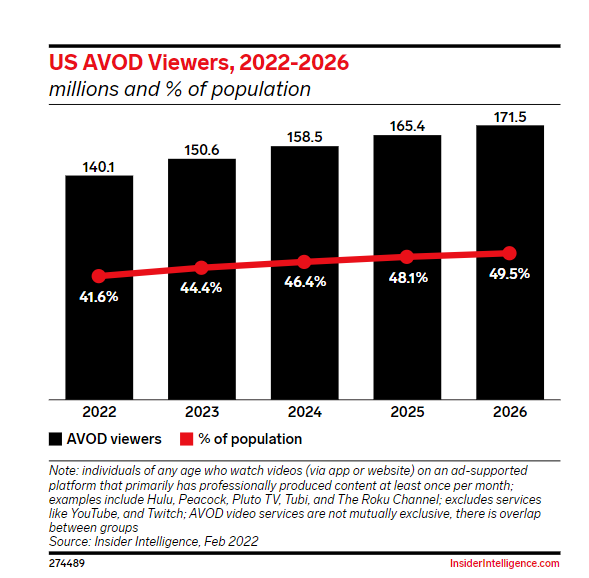MARKETING
What’s Advertising Video on Demand (AVOD) & How Does It Work?

In a world where streaming platforms reign supreme, the way we consume media is constantly evolving. One term that’s been making waves lately is AVOD, or Advertising-Based Video on Demand. In fact, eMarketer projects that over half of the U.S. population will be watching content from at least one ad-supported streaming service monthly by 2026 and more than half of all U.S. internet users (55.8%) will be watching content via AVOD services by 2026.
In this post, we’ll explore the ins and outs of AVOD including how it works, benefits, challenges, and examples. From the rise of streaming advertising to the ever-expanding universe of VOD platforms, we’ll get into what sets each apart and how they’re reshaping the way we experience entertainment.
What is AVOD?
AVOD, or Advertising-Based Video on Demand, is a video-on-demand monetization strategy employed by streaming platforms to offer users access to content at little to no cost, with revenue generated through advertising. Unlike subscription-based models like SVOD (Subscription Video on Demand), PVOD (Premium Video on Demand), and TVOD (Transactional Video on Demand), where users pay to access content, AVOD platforms typically provide their services for free or at a nominal fee.
AVOD operates on the principle of offering users a wide array of content without upfront charges, with the platform relying on advertisers to foot the bill. This model has gained significant traction in recent years, particularly as streaming services continue to proliferate and consumers seek cost-effective alternatives to traditional cable TV.
With millions of users in the U.S. alone utilizing AVOD services, it’s clear that people are drawn to the ease and accessibility of free content, even if it means enduring occasional advertisements. In exchange for access to their favorite shows and movies, users are often willing to trade some of their personal data and time spent viewing ads.
For advertisers, AVOD presents an opportunity to reach highly targeted audiences. By leveraging user data and sophisticated targeting algorithms, advertisers can deliver tailored advertisements that resonate with viewers, maximizing the effectiveness of their marketing campaigns.
As for how the ads work, AVOD platforms offer various ad formats to advertisers, including pre-roll ads (which play before the content), mid-roll ads (which appear during breaks in the content), and post-roll ads (which play after the content). Some platforms may incorporate display ads or sponsored content alongside the video player interface.

How Does AVOD Work?
AVOD operates on a simple yet effective premise: offer users access to content at little to no cost, while leveraging targeted advertising to generate revenue. But how exactly does AVOD work behind the scenes? Currently, there are two options to buy OTT ads: CSAI and SSAI. Let’s break down each.
How Client-Side Ad Insertion (CSAI) Works
CSAI, or Client-Side Ad Insertion, is a method of delivering video ads in real-time, keeping content and ads separate. This allows the client to request ads based on existing data and data collected during the viewing session.
In CSAI, when the video player identifies ad markers in the stream, it pauses the content and sends a request for an ad to the ad server. The ad server then selects an ad and delivers it to the client, where it is played during the paused content.
The real-time nature provides advertisers with complete control and facilitates accurate audience targeting.
How Server-Side Ad Insertion Works
SSAI, or Server-Side Ad Insertion, ensures a smoother viewing experience by seamlessly integrating ads into the video stream. Ads are stitched into the content, ensuring consistent delivery across various devices.
In SSAI, when a viewer encounters an ad break, prefetched ads from the ad server are seamlessly integrated into the stream by the stitching service. The stitcher selects an ad rendition that matches the video stream’s bitrate, frame rate, and audio level before delivering the content back to the viewing device.
Examples of AVOD Platforms & Services
There are a wide variety of AVOD platforms and services available to consumers. Let’s check out a few of the top options…
YouTube
With over 2 billion logged-in monthly users and more than 500 hours of video uploaded every minute, YouTube is a behemoth in the AVOD space. It offers a vast array of free content, ranging from user-generated videos to professionally produced shows and movies.
While signing up and uploading content is free, viewers often encounter ads before, during, or after videos. YouTube shares ad revenue with content creators, incentivizing them to produce high-quality content.
Hulu
Hulu boasts millions of subscribers and offers a variety of subscription plans, including an AVOD option. The AVOD plan comes at a reasonable monthly price and includes ads during content playback. Alternatively, subscribers can opt for an ad-free plan, which comes at a higher price point, providing an uninterrupted viewing experience.
Tubi
Tubi is an entirely free, ad-supported streaming service with a vast library of content, offering a mix of movies and TV shows. It features content from both small production companies and major studios, including classic titles and niche genres.
Crackle
Crackle is a free streaming service owned by Sony, offering a range of movies, TV shows, and original programming. Similar to Tubi, Crackle relies on ads to support its free content model.
The Roku Channel
The Roku Channel is Roku‘s free streaming service, offering a mix of movies, TV shows, and live TV channels. It features both licensed content and Roku Originals, all supported by ads.
Pluto TV
Pluto TV is a free ad-supported streaming television service with 250+ channels and thousands of on-demand options, owned by Paramount. Pluto TV presents its content in a similar format as linear broadcast programming, except the channels tend to focus on a single TV show (such as CSI Miami) or a similar grouping of content (such as 00s Replay).
These examples showcase the diversity of AVOD platforms available, catering to different preferences and viewing habits. Whatever you’re looking for as a consumer or as an advertiser, there’s an AVOD platform to suit your individual needs.
Advantages of Using AVOD
There are a variety of advantages of using AVOD platforms coming from an advertising perspective, let’s take a look at each.
High Viewership
AVOD platforms boast a massive viewership base, with millions of users worldwide. Market research indicates significant growth in the AVOD sector, driven by factors such as increasing internet penetration, changing viewing habits, and the proliferation of digital devices. This large and diverse audience provides advertisers with ample opportunities to reach their target demographics effectively.
Ad Targeting
AVOD platforms offer sophisticated targeting capabilities, allowing advertisers to precisely target specific customer segments based on demographics, interests, behavior, and more. This targeted approach enhances the relevance and effectiveness of advertisements, maximizing ROI for advertisers. Advertisers can also leverage first and third-party data from existing marketing strategies to further refine their targeting efforts on AVOD platforms.
Flexibility
With a variety of AVOD platforms available and a wide range of ad formats to choose from, advertisers gain flexibility in how they place their ads. Whether it’s pre-roll, mid-roll, or post-roll ads, display ads, or sponsored content, advertisers can tailor their ad placements to suit their objectives and budget.
Support for Unique Content
AVOD platforms serve as a breeding ground for unique and emerging content, providing independent creators and small publishing companies with a platform to showcase their work and monetize their content through ad revenue. This democratization of content creation encourages creativity in digital media, giving audiences a wide variety of content choices.
Inexpensive for End Consumers
As consumers seek cost-effective entertainment options, ad-supported streaming services have become increasingly popular. Many platforms, including traditionally subscription-based services like Netflix and Disney+, have introduced ad-supported tiers to cater to this demand. This allows consumers to access a vast library of content at a reduced cost, supported by advertisements.
Similar Ad Structure to Linear TV
AVOD platforms mimic the ad structure of traditional linear TV, where it’s common to watch ads during TV programs. This familiarity makes it easier for viewers to accept ads as a trade-off for accessing free content. Ad breaks are seamlessly integrated into the viewing experience, ensuring minimal disruption to the user experience.
AVOD platforms offer advertisers a powerful combination of high viewership, precise ad targeting, flexibility in ad placements, support for unique content, cost-effectiveness for consumers, and a familiar ad structure similar to traditional TV, making them an attractive choice for advertisers looking to reach their target audience effectively.
Challenges with Using AVOD
Now, let’s take a closer look at two challenges associated with using AVOD platforms.
Disruptive Ads
One of the primary challenges with AVOD platforms is the potential for ads to be disruptive to the user experience. Users may encounter too many ads, irrelevant ads, or repetitive ads, leading to frustration and a negative perception of the platform. This can prompt users to upgrade to ad-free plans or resort to ad-blocking tactics, reducing the effectiveness of advertising efforts. To alleviate this challenge, advertisers should ensure that the chosen platform maintains a balance in ad frequency, enforces standards on the ads served, and offers controls for ad frequency.
Attribution and Measurement Challenges
Another challenge faced by advertisers on AVOD platforms is the difficulty in accurately measuring the impact and effectiveness of their ad campaigns. While some AVOD providers offer in-platform analytics tools, these may not always provide the level of granularity and insights that advertisers require. Without robust TV measurement and analytics capabilities, brands may struggle to understand the true impact of their ads and optimize their campaigns accordingly.
Additionally, attributing conversions and other key metrics to AVOD ads can be challenging, particularly without the use of external measurement solutions. Advertisers may find it challenging to justify ad spend and demonstrate return on ad spend without comprehensive measurement and attribution tools in place. Implementing solutions that enable measurement of the incremental impact of AVOD ads on larger campaigns can help address this challenge and provide advertisers with actionable insights to optimize their OTT advertising strategies effectively.
“At Tinuiti, we’re equipped to deliver precise attribution insights for non-click-based platforms through diverse measurement techniques. These methodologies assess the impact of media on business results across the entire funnel. Our approach hinges on leveraging the proprietary Bliss Point pixel and graph-based strategy, which goes further to encompass incrementality and marketing mix modeling. We’ve led the way in developing a solution that can meet the evolving needs of our clients’ businesses.”
Melinda Lee, VP, Media Strategy at Tinuiti
Key Stakeholders in Advertising-Based Video on Demand
In the world of Advertising-Based Video on Demand (AVOD), several key stakeholders play vital roles in shaping the ecosystem:
Publishers: These are the streaming services that host content and strive to acquire in-demand content from creators and companies at reasonable prices. Publishers earn revenue when viewers watch ads, thus catering to advertisers by offering better targeting options and a platform for their ads.
Advertisers: Advertisers pay for ad space on AVOD platforms and prioritize factors like ad targeting capabilities and the impact of ads on metrics such as brand awareness and conversions. While AVOD offers more measurability than linear TV, advertisers may lack adequate measurement tools to optimize their investments fully.
Content Creators & Production Companies: Content creators and production companies host their content on AVOD platforms in exchange for a share of ad revenue or a fee. AVOD platforms often showcase content from independent creators, small production companies, or older content from larger production companies.
Users: End consumers form the user base of AVOD platforms and seek to enjoy content while accepting ads and sharing first-party data in exchange. Typical users span various demographics, contributing to the platform’s diverse viewership.
Together, these stakeholders collaborate to sustain and evolve the AVOD landscape, balancing the interests of publishers, advertisers, content creators, and users to create a thriving ecosystem of ad-supported video content.
AVOD, SVOD, TVOD, PVOD… What’s the Difference?
In the realm of on-demand video services, various revenue models and user experiences cater to diverse preferences and needs. Let’s take a look at the major differences as well as the pros and cons of AVOD, SVOD, TVOD, and PVOD.
SVOD vs. AVOD
SVOD (Subscription Video on Demand) services offer access to content through a subscription fee. Users pay a recurring fee to access a library of content without encountering ads.
- Examples include Amazon Prime Video, Disney+, and Hulu’s premium subscription tier.
- Pros: Offers ad-free viewing experience, wide content selection.
- Cons: Requires ongoing subscription commitment.
AVOD (Advertising-Based Video on Demand):
AVOD services provide free or low-cost access to content, supported by ads. Users can watch content for free but may encounter ads during playback.
- Examples include YouTube, Tubi, and The Roku Channel.
- Pros: Free or low-cost access to content, broader audience reach.
- Cons: Potential for ad interruptions, limited content availability compared to SVOD.
TVOD vs. AVOD
TVOD (Transactional Video on Demand) services offer content on a pay-per-view or rental basis. Users pay for individual titles or rentals to access specific content.
- Examples include Amazon Prime Video’s rental service and Apple iTunes.
- Pros: Pay only for what you watch, access to new releases.
- Cons: Higher cost per view, no access to subscription library.
PVOD vs. AVOD
PVOD (Premium Video on Demand) services offer premium content for a higher rental or purchase price, often before its traditional release window. Users pay a premium fee to access early-release content from the comfort of their homes.
- Examples include recent movie releases available for rental or purchase on digital platforms.
- Pros: Early access to new releases, convenience of home viewing.
- Cons: Higher rental or purchase price, limited availability.
While SVOD offers subscription-based access to ad-free content, AVOD provides free or low-cost access supported by ads. TVOD allows pay-per-view access to specific titles, while PVOD offers early-release content for a premium fee. Each model caters to different preferences and needs, offering users a range of options to enjoy on-demand video content.
Conclusion
As more viewers flock to AVOD platforms seeking cost-effective entertainment options, advertisers have a unique opportunity to reach their target audience effectively. The growth of AVOD platforms has been remarkable, with millions of users worldwide embracing the free or low-cost content offerings. It’s time to capitalize on this expanding audience base and target consumers in a highly engaging environment.
Interested in learning more about AVOD? Contact us today or check out the robust TV & Audio Services we offer at Tinuiti to find a solution to best fit your needs.


















